This article aims to help you discover and master the art of agile project management so you can turn your challenges into concrete successes. 🏆
But first, I’m sure that the term “project management“, which is a very general one, doesn’t speak to everyone and needs a little clarification! ⛏️
🎯 In this case, it encompasses all activities aimed at organizing the smooth running of a marketing project, and achieving objectives effectively and efficiently. That is, within the constraints of time, budget and quality.
➡️ When managing a project, there are 5 stages to go through: conception, planning, execution, monitoring, control and finalization. To do this :
- We adopt a defined, pre-selected process for project execution.
- Knowledge, skills, tools and techniques are applied to all activities.
🦄 There are many marketing project management methods, each with its own advantages and disadvantages. The choice depends on the nature of the project, the organization, the types of activities, the group’s preferences…
For our part, we’re going to take a closer look at agile project management methods (as opposed to traditional models). 🤸🏼♀️ If you don’t know what that is, get ready to move from chaos to clarity! 💡
⬇️ Here’s the program:
- Agile project management: definition, context and benefits.
- Top 4 agile project management methods
- Case studies: Spotify and Twitter
- Tips for choosing the right method and tools
We’re off! 🤩
Agile Project Management : Definition, Context And Benefits
The Definition Of Agile Project Management
👉🏼 As you’ll have gathered by now, the term “agile” refers to a project management method that combines iterative and incremental approaches (we’ll see exactly what these approaches are later on).
Agility focuses on value delivery and continuous improvement, but also on values such as collaboration, adaptation, self-organization and transversally. 💎
🤝 We speak of co-design between all stakeholders, who aim to find the best solutions to meet the project’s challenges and create maximum value.
The model is based on the setting of short-term iterative objectives, as well as on the evolution of requirements and solutions through. 🔄
🧩 A major project is broken down into stages and/or sequences taking place one after the other: these are known as sprint. 🏃🏻♂️ Sprints are made up of several stages, generally consisting of the following:
- Retro-planning.
- Design.
- Development.
- Testing and verification.
- Demonstration and/or deployment.
- Evaluation of results.
- Gathering comments and/or information.
- Establish new rules and move on to the next sprint (the solution doesn’t need to be completely finalized, just functional).
Flexibility and adaptability are the watchwords of this method. 🤸🏼♀️ We recommend using it when you’re unsure of the specifications from the outset, or when you lack visibility of how the project will evolve. 🧐
In short, agile project management is applicable to a multitude of activities and projects. That’s why it’s now a must-have and used by almost half of all organizations, according to an international study conducted in 2020 by Organize Agile. 🔍
Emergence Of The Agile Project Management Methods
📣 As a reminder, project management isn’t new, since it’s a concept that’s been used for hundreds of years. But the concept of “agile project management” is much more recent, having emerged in the 2000s.
Originally, organizations were dissatisfied with traditional project management approaches (predictive V-model method). They wanted to find a less constraining way of improving and accelerating the development process. ✨
After years of research, the Agile Manifesto that introduced the method, and proven feedback based on tangible indicators… 💥 Its effectiveness has finally been demonstrated with certainty.
🖱️ It first began to be democratized in the IT frameworks sector, and then beyond. These principles are now used by all functions in organizations, and several have been created.
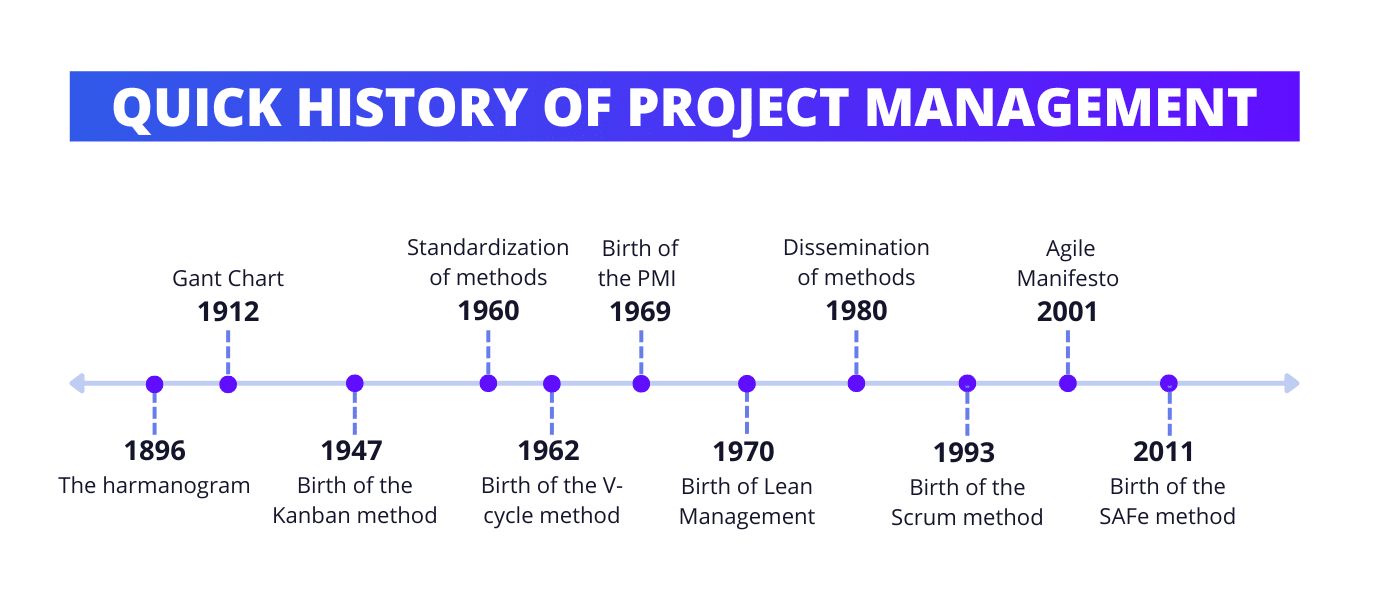
At the end of the article, we provide examples of major companies using this method, along with their unavoidable principles. 🤩
But first, let’s explain what has convinced millions of organizations around the world to use it, and how they do it. 👇🏼
Benefits Of Agile Project Management
🎁 If agile methods has convinced so many people, it’s because it has more to offer than other models and its benefits are not negligible.
They are flexible and adapt easily to change. This means they can react quickly to new requirements and unforeseen events. In particular, thanks to the division of labor into small iterations, they can deliver results quickly and adapt to change. 🎢
💎 In short, what distinguishes the agile project management method is its ability to :
- Offer a faster, more flexible and more efficient way of managing unforeseen, deadlines, adjusting or reducing.
- Produce more in less time, and offer greater flexibility to take advantage of opportunities as the project progresses.
- Integrate the customer into the construction of the project to improve their satisfaction and adapt more easily to their expectations.
- Encourage employee autonomy and bring all professions within the same group to share knowledge.
- Enhance management efficiency and the chances of achieving profitability targets, even in an uncertain and rapidly changing environment.
- Strengthen an organization’s market position and culture through a constructive approach.
Finally, all agile project management frameworks share five main components (inspired by the 12 principles of the Agile Manifesto): cadence, synchronization, and quality development practices. 📚
We’ve just listed all the reasons why others have chosen to use it. And, we’ve also listed the reasons why you should use it too 😉
Obviously, there are several agile project management methods to choose from. 🌈 So, stay with us, we’ll introduce you right away!
Top 4 Most Commonly Used Agile Project Management Methods
💡 It’s time to help you choose the agile project management method best suited to your project and/or business, from among the main existing models.
1. Scrum Method
Scrum is the most popular agile project management method today. 👑
👀 Quite simple, it is dedicated to single-team management and aims to make visible the effectiveness of management techniques, work environment, so that improvements can be made.
It is based on a lightweight and agile framework for developing and maintaining complex projects. It helps individuals, teams and organizations generate value through adaptive solutions. 🤸🏼♀️
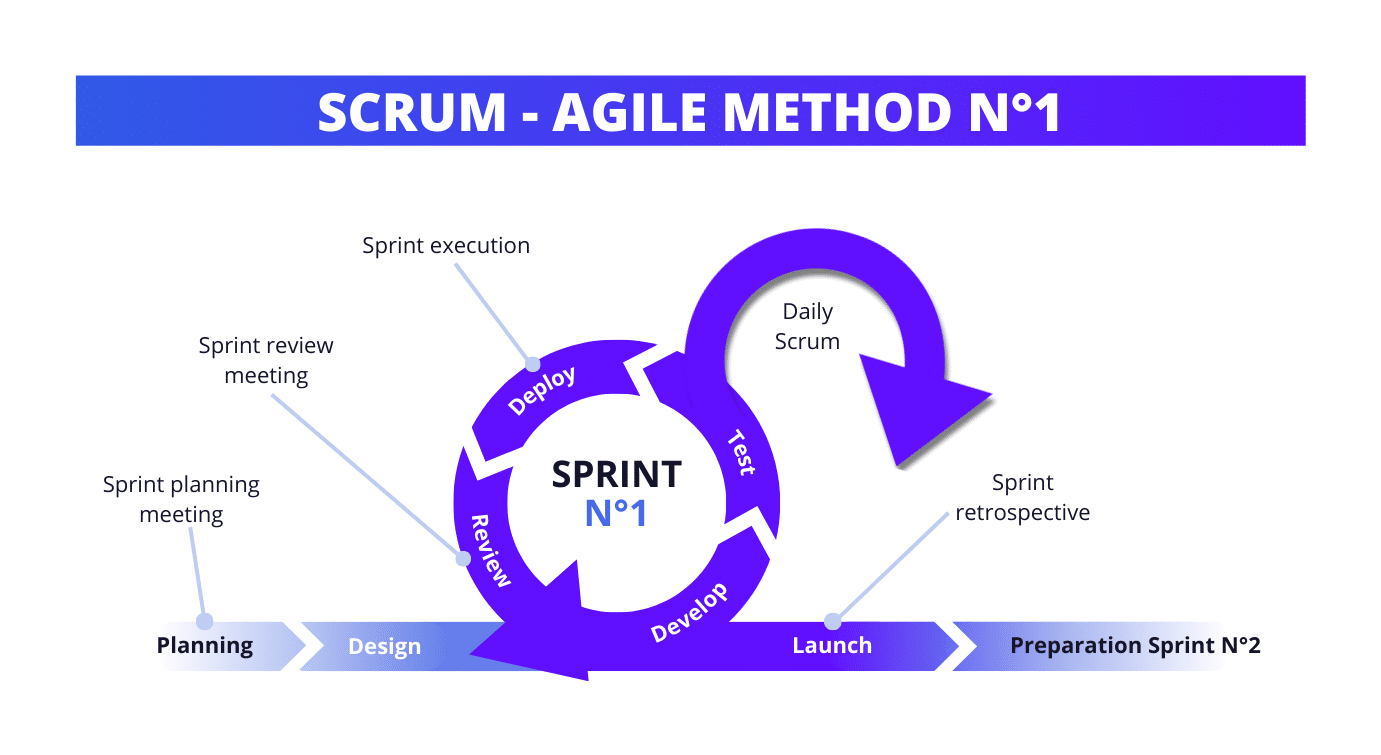
This agile project management method is based on two concepts ♻️ :
- Empiricism asserts that knowledge comes from experience and from making decisions based on what is observed, tested, approved and known.
- Lean management, is an agile project management method in its own right, reducing waste and focusing on the essential value or added-value production.
It also uses an iterative and incremental approach, with three essential pillars involving specific roles, events and artifacts.
The entire model structure is designed to optimize predictability and control risk. ☢️
1. Transparency: the progress of the work must be visible to all stakeholders. 👀
- What represents value here are the artifacts (product backlog, sprint backlog and increment). They are designed to maximize the transparency of key information.
- Artifacts with low transparency can lead to decisions that decrease value and increase risk.
- Without “transparency”, there can be no inspection, as it would be misleading and costly.
2. Inspection : progress must be inspected. 🔍
- This step enables us to detect any deviations or potentially undesirable problems.
- To facilitate inspection and day-to-day organization, the pace is set by five events designed to facilitate change: the sprint, the planning sprint, the daily scrum, the sprint review and the sprint retrospective.
- Without inspection, no adaptation would be considered useless.
3. Adaptation: occurs when certain aspects deviate from the desired result. 🎯
- If the workflow deviates from acceptable limits, or if the result obtained is unacceptable, the process must be adjusted as soon as possible (to reduce any further deviation).
- The group is expected to adapt as it learns something new through inspection. Adaptation becomes more difficult if members are not prepared for it.
- The Scrum team must therefore bring together people who collectively have all the skills and expertise to apply the model, share or acquire skills… Team members include developers, a product owner and a scrum master (or the manager).
🏆 Scrum‘s success depends on group members recognizing themselves through five values: commitment, focus, openness, respect and courage.
The structure of the method is deliberately incomplete, defining only the parts required. ❌ It builds on collective intelligence rather than providing detailed instructions.
2. SAFe Method
SAFe, or The Scaled Agile Framework, takes the agile method beyond the confines of a single team and integrates it into the company’s overall strategy. 🗺️
SAFe is a cross between Agile, Lean and DevOps. 🔀 It focuses on the detail of practices, roles and activities at the management of portfolio, program and team management levels.
🗓️ Work is planned in batches, so that problems can be identified earlier and progress is visible in real time. Ongoing rituals can also be regularly inspected and adapted.
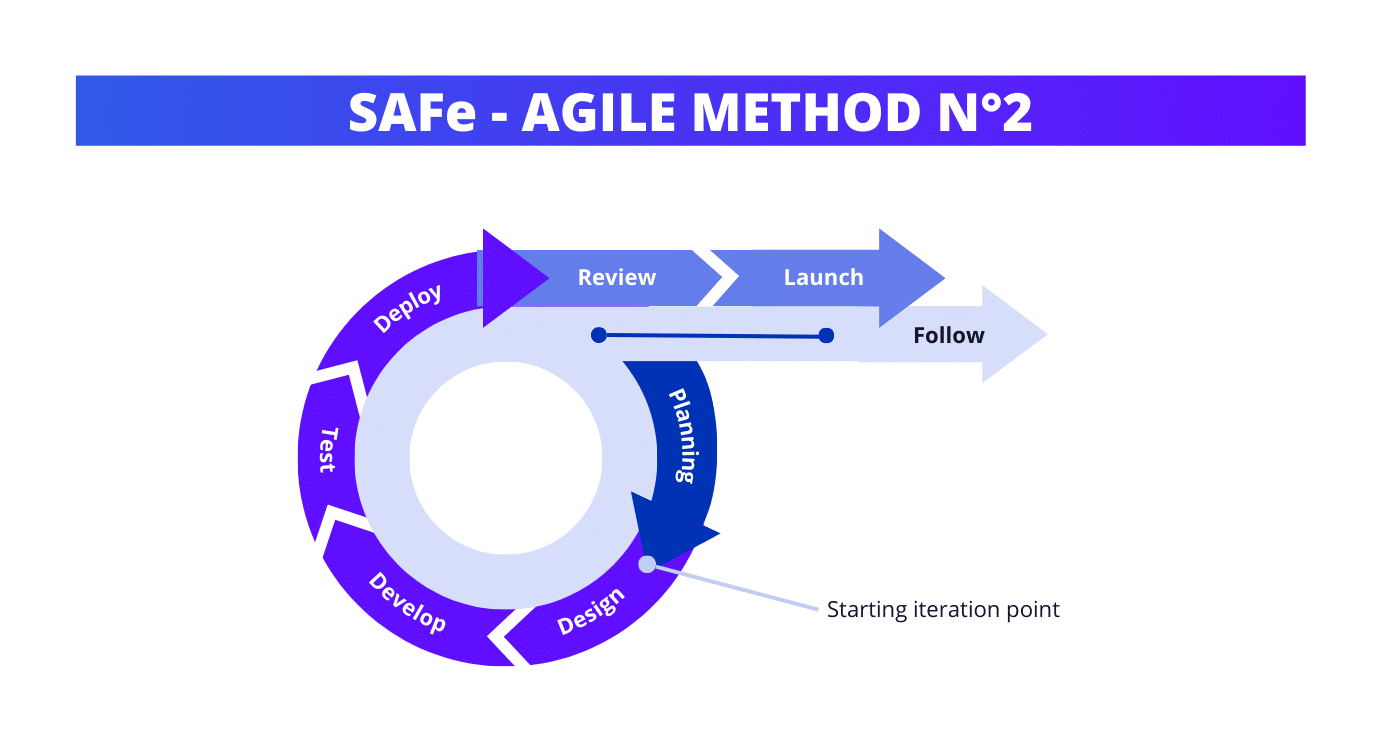
To integrate agility at all levels, the method provides a knowledge base and establishes a common language as well as common foundations through various core values 👇🏼 :
- Alignment of business objectives to cope with rapid market changes.
- Integrated quality at every level.
- Exceed agility requirements.
- Trust and transparency.
- Program execution (ability to deliver a functional, high-quality project).
- Lean/Agile management and leadership to create the right environment and transform systems.
➡️ Next, SaFe can be configured and implemented in 3 levels, distinguished by their level of ease of implementation, the type of organization or activity and finally the quantity of elements to be integrated (roles, events, artifacts and skills).
Typically, this model is used by companies with hundreds or thousands of teams, operating in ART mode (Agile Release Train). That is, with a cross-functional team bringing together several agile and multiprofile groups. 👥 With smaller organizations, this method will have no impact.
✋🏼 It is used, for example, when the following needs are identified:
- Bring greater coherence to the overall strategy.
- Standardize objectives and organization.
- Greater flexibility between groups and players.
- Streamline and facilitate development/delivery.
If you’re interested, the latest version of the method is now based on 10 principles, derived from Agile and Lean methodologies, but also from observation of successful companies. 📈
Please note that the application of a new model is not a miracle solution. 🤷🏻♀️ Furthermore, the complexity of SAFe’s application could dissuade many from using it, as it requires :
- Reorganization or even redesign of the entire organization.
- Rewriting and introducing new processes.
- Technical installation and familiarization with new tools.
- Culture change and learning agile values.
- A colossal task of adaptation and understanding.
- A multitude of roles and events to set up.
⚙️ For your information, there are several sources providing a roadmap for implementing SAFe (with detailed steps for getting started and configuring the organization for widespread adoption across all portfolios).
🆙 Finally, there are others Scale-up techniques that we won’t detail here: LeSS, Nexus, Scrum@Scale, Scrum of scrums, Lean Software Development, Disciplined Agile Delivery (DAD)…
3. Kanban Method
Kanban is a flexible agile project management method based on the Lean approach. ♻️ It is inspired by an inventory control and stock management system that enables on-demand production.
⏱️ It is based on the principle of rapid delivery and aims to :
- Continuous improvement and reduction of production costs.
- Achieving balance between production and demand.
- Eliminate waste and avoid stockpiling as much as possible.
- Reduce lead times and achieve fair, high-quality production.
- Foster collaboration to solve problems and improve quality.
- Optimize team responsiveness.
ℹ️ Kanban is a visual information system that makes use of the programs already in place and encourages their improvement. It’s also the model that provides the quickest feedback and the best control of workflow, thanks to a chart. 👁️
It consists of a system of labels or pull cards. 🏷️ Each card corresponds to a request that triggers production, and contains the tasks to be carried out as well as various instructions.
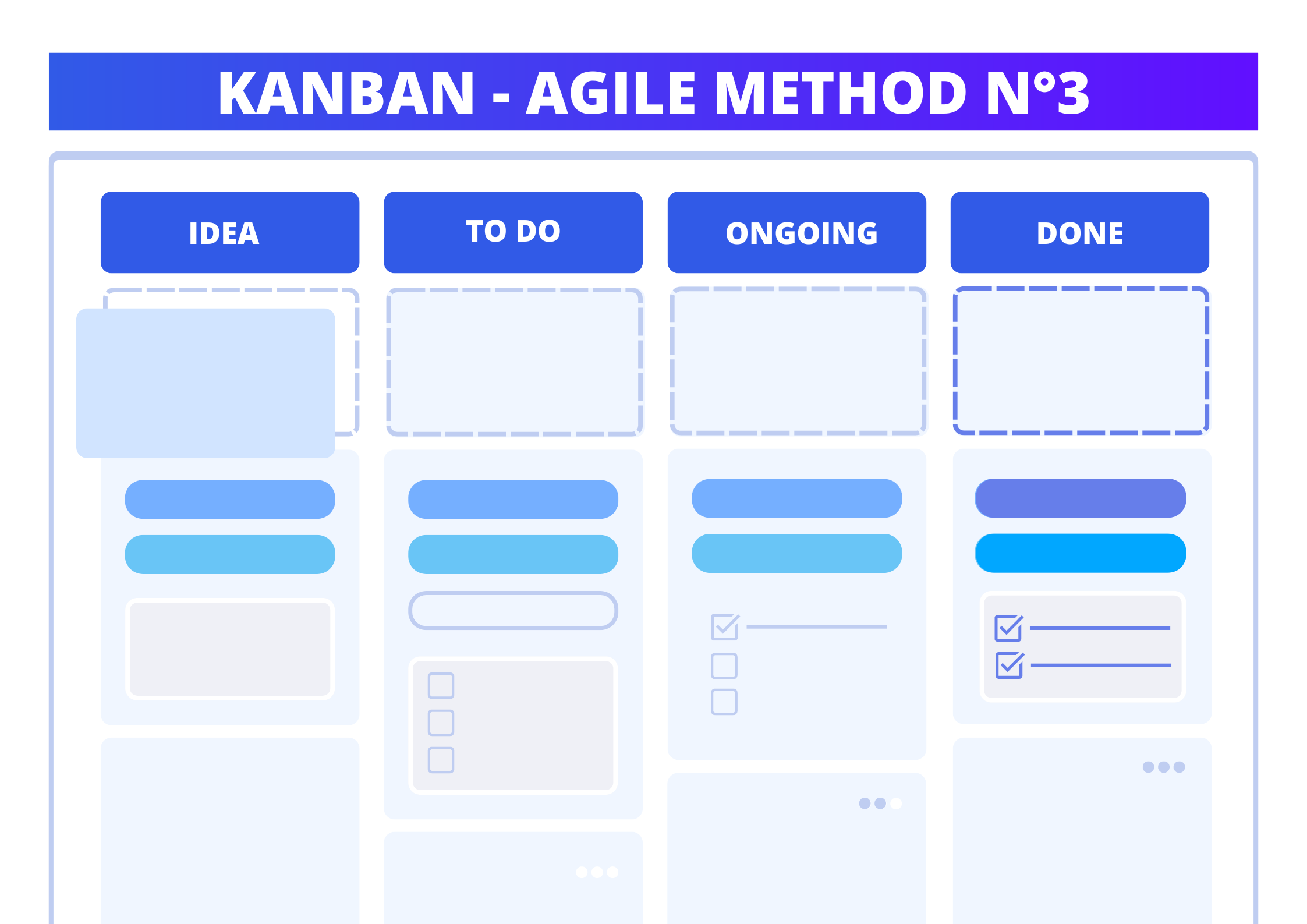
👩🏻🏫 The board is the major asset of this method, as it enables the team to :
- Visualize and manage the flow.
- Identify visible obstacles or opportunities.
- Adjust process limits in real time.
- Improve efficiency and productivity.
- Collaborate, communicate and circulate information on tasks to be carried out.
💡 If you want to adopt this method, here are some tips:
- Don’t try to change everything overnight, start with what you’ve got and agree to improve the existing system through gradual changes.
- To eliminate the fear of change, respect the roles, responsibilities and professional titles of each group member.
- All players within the organization must be involved in the process.
- Labels provide a framework, but one that must remain flexible and adaptable.
Last but not least, the Kanban system can be adapted to a variety of working modes (individual, team or even organizational), but not to all production levels. When the production rhythm is irregular, the method no longer works. ❌
⚙️ Much software and marketing tools use the Kanban method, such as Click-up, Miro, Trello, Jira…
4. Dynamic Systems Development Method (DSDM)
DSDM, or Dynamic System Development Method, is an agile project management method, initially reserved for software, which follows an iterative, progressive and incremental logic; mainly inspired by the Rapid Application Development (RAD) model. 📲
🤝 DSDM actually came into being thanks to the cooperation of the industry’s RAD approach leaders, to solve a problem posed by RAD, namely its lack of structuring and the absence of common processes between teams.
It is mainly used for projects with very tight delivery deadlines, and aims to deliver at the end of each iteration. ⏱️ Of course, within budget, while adapting to changes and modifications.
🧑🏽⚖️ It applies Pareto’s law, so it doesn’t take long to reach a stage where the product can be said to working (80% system deployment in 20% time).
The DSDM is therefore a lightweight, effective and adaptable method that provides a four-step framework, including 👇🏼 :
- Feasibility and business study.
- Functional model / prototype iteration.
- Design and build iterations.
- Execution/Application.
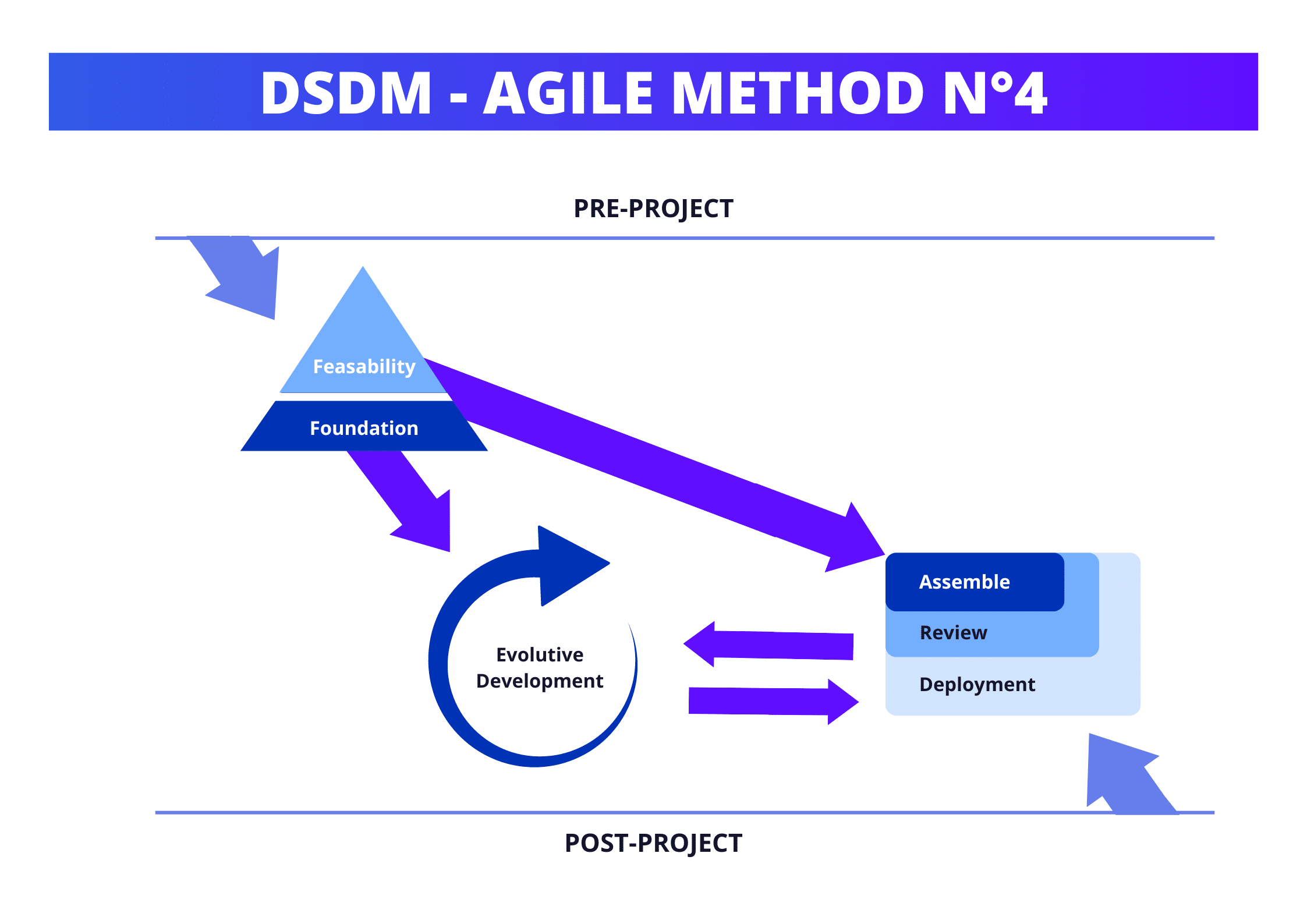
💎 The method is also based on four core values… :
- Individual : Valuing people who work on the project and are more familiar with the practical side.
- Functional software (version used by the end user).
- Essential collaboration for a functional project (e.g. cross-functional team, co-location with customer, animation workshop…).
- Responding to change : prioritize Welcoming and all changes required to adapt/respond in a highly innovative way.
…As well as nine fundamental principles, focused on business needs and distinguishing this model from others 👥 :
- User involvement: Permanent, ongoing and active contact with a small, selected group to reduce errors in user perception, cost of rework, etc.
- Empowered teams: Encourage empowered decision-making (⚠️ can potentially be a critical point).
- Frequent delivery: Guarantee that errors/bugs are identified, dealt with and resolved/reversed/corrected at an early stage.
- Ability: to meet a business need and accept modifications or improvements in a subsequent iteration. DSDM does not create ad hoc software. ❌ It keeps the process flow simple and efficient.
- Incremental development: Breaking down a major project into several sequences of functionalities delivered to customers with each delivery (up to the complete package or finished product).
- Reversible modifications: Iteration occurs in small increment and modifications are reversible (little risk of total loss of progress).
- Define requirements: Limit the degree of freedom needed to make changes.
- A/B testing integrated and carried out during development to ensure that the product(s) is (are) free from technical defects (solve problems early to reduce rework, costs and lead times).
- Stakeholder cooperation: Value creation, compliance with precise requirements and honest feedback on results can only take place if trust and honesty prevail.
We’ve now finished presenting the four main agile project management methods: Scrum, Kanban, SAFe and DSDM. 🎬 If you’d like to find out about other existing models, we’ll give you a few pointers in conclusion.
To make it easier to understand, we’d like to share with you some use cases of agile project management techniques in large companies. 👇🏼
Agile Project Management Study Cases : Spotify And Twitter
Project Tracking With Twitter
🐦 Twitter (new X) is an emblematic social media with thousands of employees and hundreds of different teams. The structure began to take an interest in agile project management methods in 2010.
In 2019, at Hack Week, a senior application engineer at Twitter, proposed modifying the Jira tool to help the experience development team better manage and track work. 🧠
So they developed a script that aligned a project model for all types of problems, flows and screens. 🤯 The project is called Experience Project Tracking and was an immediate success.
🎉 A second project was therefore immediately born and directly approved : Unified Project Tracking. This project is based on the same structure as Experience Project Tracking, but focuses on objectives, asynchronous mode and accessibility.
⚙️ New features have also been added to organize the work of each team:
- The hierarchy of new and existing projects.
- Follow-up and accountability.
- Problem type customization.
- Data-driven prioritization.
- Link and dependency mapping.
- …
↔️ By creating an experience with standardized flows between groups, unified project tracking has enabled teams and managers to :
- Measure progress more easily and execute more efficiently.
- Easily establish the critical path of a business plan and explore different variants.
- Take the plunge, knowing where to focus your attention.
- Strategic planning and monitoring.
Twitter’s use of agile project management techniques has transformed teamwork throughout the organization. 🏆 Which has therefore earned it the Best in Class (technical) award in 2021.
Spotify
🎶 Spotify is a leading digital music service and is known for its dynamism and technological know-how. The company began applying agile project management techniques in 2008.
After several test phases, Spotify’s choice quickly fell on the Scrum method. Unlike Google’s “basic” strategy, Spotify adopted this model with a systemic approach. 🔍
Their vision and key principle was to live and breathe Scrum as a development methodology. 😮💨 Spotify’s Scrum masters then became experienced agile coaches or leading agile trainers.
The digital music service has formed small, totally independent teams called “squads”, which are treated like individual startups. 🚀
They are allowed to be totally autonomous and work independently to focus on specific functions assigned within the product. 🖱️
🦾 The added advantage of the latter is that they can make changes and provide upgrades without interfering with other teams’ projects.
This approach seems to balance independence with knowledge sharing between specialized groups, who do not engage in day-to-day collaboration. ⚖️ At the same time, Spotify has avoided scaling problems by decoupling where possible.
What made this approach so successful was the rapid removal of obstacles and problems as soon as they arose. It has enabled and continues to enable Spotify to act, grow and deliver software updates quickly. 🔄
As you can imagine, deploying and integrating agile project management methods is no mean feat. Spotify and Twitter took years to find their model. ⌛️
👉🏼 If you’re looking for other use cases for agile project management models in companies, here are a few: eBay, Walmart, Verizon, Airbus, AXA, Orange Bank…
Conclusion : How To Choose The Right Method And Tools?
In conclusion, choosing to invest in agile project management can be highly beneficial for groups and organizations, as it helps them achieve better results more efficiently. 🎯
💡 Here’s a rough guide for choosing the right agile project management method for your marketing strategy :
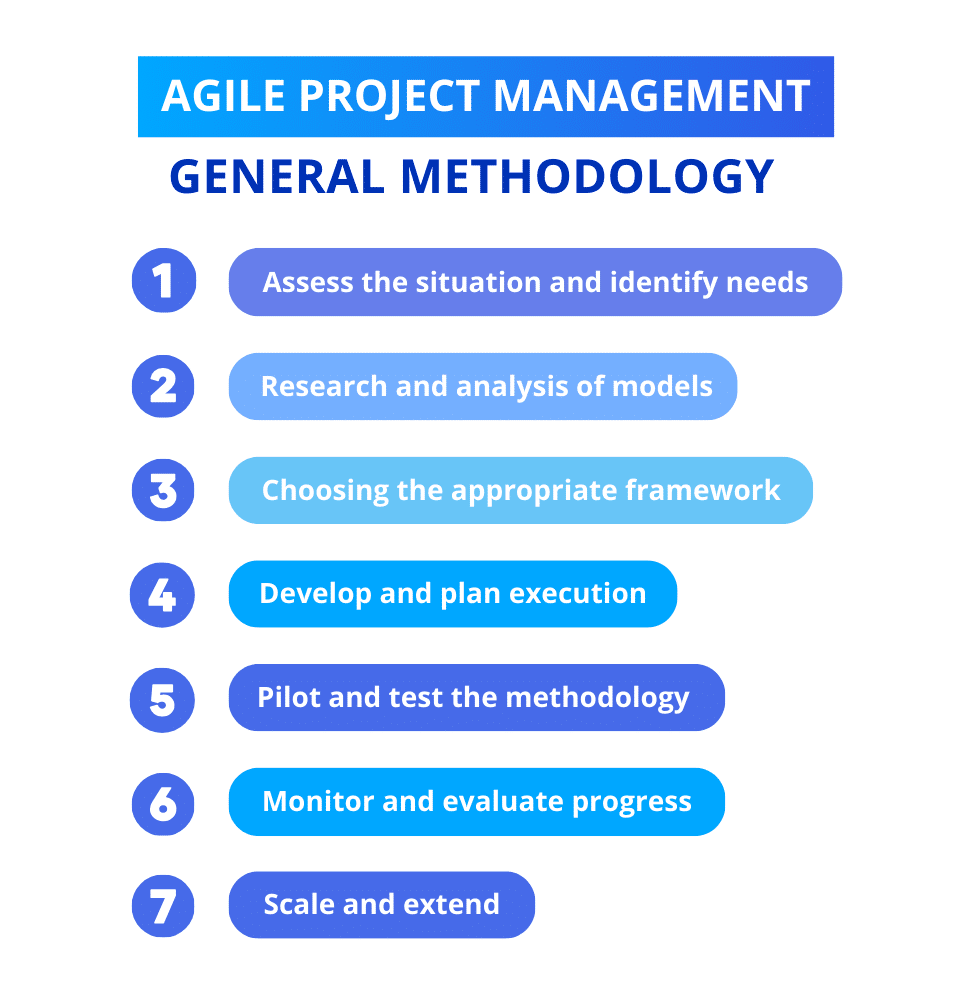
1. Assess the situation and identify needs : type of project, time and budget constraints, SMART goals, level of customer or team involvement, appropriate methodology…
2. Research and analyze different agile models : In this article, we’ve talked about Scrum, SAFe, Kanban, Lean, RAD, DSDM… But there are plenty of others 👇🏼 :
- Agile Unified Process (Agile UP or AUP),
- eXtreme Programming (XP),
- Feature-Driven Development (FDD),
- Crystal,
- Agile Data,
- Adaptive software development (ASD)
- Behavior-driven development (BDD)
- DDD domain-driven design
- Test-driven development (TDD)
- Rational Unified Process (RUP)
- Enterprise Unified Process (EUP)
3. Choose the right framework ✅ : factors to consider include team size, project complexity, culture, brand image… Finally, we recommend that you apply a single method, from the design stage through to project completion.
4. 📆 Plan and develop a plan for execution (definition of roles, training and resource requirements, communication plan…)
5. Pilot and test the methodology 🕹️, for example on a small project or team, to assess its effectiveness and identify areas for improvement.
6. Monitor progress and evaluate feedbacks the effectiveness of the new methodology 🤔 (productivity and group dynamics, quality of results, customer satisfaction and overall success of the project…), then collect 🗣️ from all stakeholders in order to make adjustments if necessary.
7. 🪜 Scale up and extend : If you manage to apply the methodology successfully on your pilot project, then you can extend it to other projects and teams within the organization. At that point, you can choose your appropriate project management tools.
NB: The order and content of the above steps is indicative, and this roadmap may be modified according to project and organizational circumstances.
You can also help yourself by using project management software!
Have you noticed that we haven’t mentioned agile project management tools at all until now? ⚙️ In fact, there are dozens of marketing software packages specializing not only in agile project management, but also in certain agile project models.
We start from the most basic, i.e. agile project management on Excel (free). 🤦🏻♀️ to the use of Enterprise Agile Planning (EAP) tools supporting agile frameworks.
Finally, as a reminder, integrating agile project management methods requires training, constant effort, learn and continuous improvement to guarantee long-term success. 💪🏼 Despite its many benefits, this methodology is not for every company or every project.
Before taking the plunge, we therefore advise you to carefully analyze your needs, your capabilities and your chances of success by investing in this solution. 🍀
Frequently Asked Questions (FAQ)
🏁 To conclude, here are the answers to the most frequently asked questions on the subject. 👇🏼
What Is The Project Management Triangle ?
The project management triangle, also known as The Triple Constraint or Iron Triangle, is a fundamental concept which illustrates the interrelationship between three interconnected variables that determine the quality of the project :
- Scope : Goals, deliverables, features, and tasks that need to be accomplished within the project. It defines what needs to be done and what is excluded from the project.
- Time : Schedule or timeline for completing the project. It includes deadlines, milestones, and the overall duration of the project from start to finish.
- Cost : Budget allocated for the project, including resources, materials, labor, and other expenses necessary to complete the project successfully.
Any change in one factor will invariably impact the other two, your project must carefully balance these constraints to achieve project success… For example:
- Increasing the scope of a project without adjusting the time or cost will likely lead to delays and increased expenses.
- Trying to shorten the timeline of a project may require additional resources or increased costs to meet the deadline.
- Decreasing the budget of a project may necessitate reducing the scope or extending the timeline to accommodate the limited resources.
What Are The Main Stages In A Project’s Life Cycle?
🔄 The project life cycle refers to the process by which a project is imagined, executed and delivered.
As we briefly mentioned at the start of this article, there are 5 essential stages in a project’s lifecycle. ✅ Let’s break them down together:
- Design : Defining the project, identifying stakeholders and obtaining their approval. It includes activities such as feasibility studies and resource selection.
- Planning : Planning the project’s activities, defining the resources required, and drawing up a timetable or retro-planning. It includes activities such as breaking down the work, estimating the budget or costs, creating a communication plan…
- Execution : This is the most difficult stage, executing the plan and carrying out the planned activities and/or tasks. Operationally, this includes monitoring progress and resolving problems.
- Monitoring and control : Monitoring and ensuring that the project is progressing according to plan. It includes activities such as monitoring costs, measuring performance indicators and managing risks.
- Finalization : This stage takes place when the products or services are delivered, and includes project documentation and performance evaluation.
What is PMO methodology?
The Project Management Office (PMO), is a centralized entity within an organization that is responsible for defining and maintaining standards and practices related to project management.
PMO methodology serves as a framework to promote consistency, efficiency, and effectiveness in project management practices across the organization, ultimately contributing to successful project delivery and organizational success.
It also refers to the set of processes, procedures, tools, and best practices established and managed by the PMO to support and govern project management activities across the organization.
The PMO methodology typically includes the following components :
- Project Governance frameworks to ensure projects align with organizational goals and priorities.
- Standardized Methodologies and Processes such as waterfall, agile, or lean, and associated processes tailored to the organization’s needs.
- Standardized Templates, Tools and Guidelines to support project planning, execution, and reporting.
- Resource Management processes for allocation, capacity planning, and resource optimization across projects.
- Performance Measurement and Reporting of key performance indicators (KPIs) and metrics defined to measure project performance and progress.
- Risk Management processes to identify, assess, mitigate, and monitor project risks.
- Quality Management processes implemented to ensure project deliverables meet quality standards and customer requirements.
- Change Management processes established to effectively manage changes to project scope, schedule, and budget.
What Are The Different Methodologies of Project Management ?
➡️ In marketing, there are 5 ways to manage a project:
- Incremental : An approach that provides finished deliverables that the customer can use immediately.
- Iterative : This criterion allows feedback on unfinished work, so that improvements and modifications can be made during the project.
- Predictive : The more traditional approach (nicknamed V-cycle or waterfall), with most of the planning upstream, then execution in a single pass; a sequential process.
- Agile (detailed in this article): simultaneously iterative, incremental and to refine elements and deliver frequently.
- Hybrid : A combination of predictive, iterative, incremental and/or agile approaches, allowing greater flexibility and delivering diverse results.
Now you know all about agile project management! See you soon! 👽









